My mother’s 21-day voyage to America, 1954
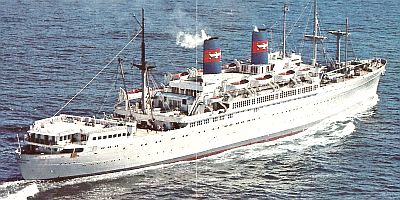
Maria Cacas came to America on the SS President Wilson. (American President Lines: The Last Ocean Liners)
WASHINGTON, DC — On Thanksgiving Day, 1991, I interviewed my father, Clemente Cacas to learn about his life as a young man. He’d first arrived in the U.S. in 1929, working and traveling with his brother, Maximino. They both served in the U.S. Army in WWII. When Max died just before the war ended, Clement settled in Washington, DC, earning decent money driving a taxi, and enjoying the life of a bachelor.
In the fall of 1953, as Clement was turning 43, his sister summoned him back home to Narvacan (Ilocos Sur) in the Philippines. She said it was time he settled down and got married. She arranged for him to marry a local Filipina. But the plans changed when he went to a local party. He met and fell in love with a young woman, Maria Bello, who lived in the neighboring town of Santa. She was almost 20 years younger than him.
After a brief courtship, he expressed his love for her in letter proposing that, “if I will have the chance to merry (sic) you…I will take you to America…I will work hard to support you (and)…I will do the best I can to make you happy.”
Shortly after the new year, they married on January 18, 1954, and after honeymooning in Baguio City, they made plans to head for the United States, finally leaving in June.
We found Mom’s travel diary, two simple pages in a tiny notebook. Over time, the pages were torn at the corners, but key dates and destinations are still legible.
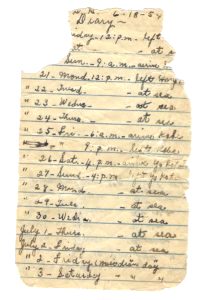
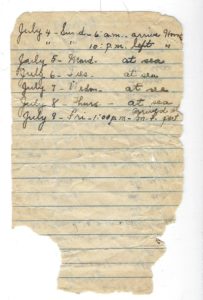
(Courtesy of the Cacas family)
This last Thanksgiving Day, our family had a chance to interview Mom to ask her about her voyage to America, more than 64 years ago. We learned some details about her journey that Mom had not talked about. For example, we had only imagined that her boat trip here was in steerage class, only to learn that her trip was equivalent to traveling today on a nice cruise ship. Also, it’s hard to imagine the journey that took 21 days by ship, today takes 21+ hours by plane.
Q: When did you come to the U.S.? How did you travel here? How long did it take? I came to the U.S. in 1954 on the SS President Wilson, which was one of the large ocean liners named for the Presidents. The trip took 21 days and 21 nights.
Q: What was it like to be so young, knowing that you’d be leaving your family? Were you scared? How did your family take it?
I was a little scared, but your dad’s parents had already gone to my parents to ask for permission to marry me. My mother was a little sad, but you had to do what your parents wanted. My brothers and sisters were still too young to understand, and besides, they didn’t have a say in the matter.
Q: Were you afraid to get on the boat? What were your feelings? Your expectations? I wasn’t afraid. My feeling was that you go in, and you will arrive somewhere when it’s over. I was very happy to be going to the U.S. with your dad.
Q: When did you leave? What ports did the ship dock?
The boat left Manila on Friday, June 18. Two days later, the first stop was in Hong Kong, to pick up more passengers. We sailed around for a week along the coast of Japan. There were two stops to pick up more passengers in Kobe and Yokohama. The boat headed out on Sunday June 27 for a full week at sea, heading straight to Honolulu, Hawaii.
[Mom’s diary indicates two “July 2 Fridays” as their Meridian day, when the boat crossed the international date line.]
Q: How much did it cost? What were the accommodations like? What do you remember about the other passengers? Were there other Filipinos on board? Were people on the ship friendly? What was the food like
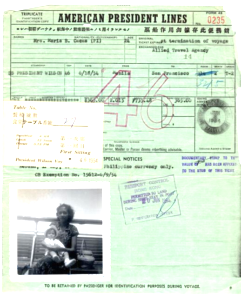
[Note: See her passenger ticket, in English and Chinese. The one-way fare was 735.48 pesos, or$365 dollars (roughly $2,000 today).]
Our meals were the first sitting at Table No. 27. Breakfast was served at 8 a.m., Lunch at noon and dinner at 5:15 p.m. Your dad would knock on the door every morning to go to breakfast. I remember that there was a family with three children, and the kids were always the first ones to run to the dining room to eat
You were already three months pregnant with your first son [“Max’s first boat trip!” exclaimed daughter-in-law, Lisa Myers]. What was it like to be on the ship? Did you get seasick?Was there stuff to do?
No, I didn’t get seasick at all. My aunt Puresa and her daughter, Janet also traveled with us. We would walk around the ship and sit on the deck to relax and enjoy the fresh air. In this picture, I am babysitting Janet, while my aunt walked around the ship.
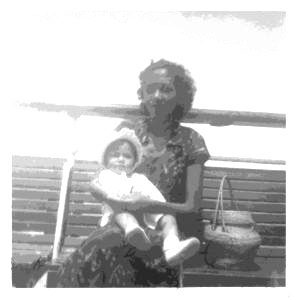
[Courtesy of the Cacas family; also published in “Images of America: Filipinos in Washington, D.C.,” by Rita M. Cacas and Juanita Tamayo Lott; Arcadia Publishing, 2009, p. 73.]
The ship arrived in Honolulu, Hawaii on Sunday July 4th(6 a.m.). My uncle and aunt greeted us. We visited with them for a few hours, then got back on the ship at 10 p.m. that night. We were back at sea for the next five days.[Note: Hawaii was not yet part of the U.S.]
Q: When did the ship arrive in California? What do you recall as you approached San Francisco?
We arrived on Friday afternoon, July 9. I remember being so excited as the ship passed alongside the Golden Gate Bridge. I’d read about it in school.
Q: Once on land, how long did you stay in San Francisco? When did you leave to head for Washington, DC?
We stayed in San Francisco for about a week, visiting family and friends, then we left on July 15.
How did you travel? How long did it take?
We took the Greyhound bus, which took 6 days. We stopped in Chicago and stayed overnight in a nearby hotel. Your dad had lived in Chicago, so he was familiar with places to stay. From Chicago, the bus headed straight to Washington, DC, with frequent rest and food breaks. We arrived at the Greyhound terminal (near Union Station) on July 20 at 8 a.m.

Celebrating Maria Cacas’ 89th birthday earlier this month. From left to rigjt Rita (daughter); Maria; Lila (granddaughter); Emily (daughter) and her husband Nilo; Jaime Bello (brother); Lisa Myers (daughter-in-law), and Chris Cook (son-in-law). ( Courtesy of the Cacas family)
Q: Where did you live when you arrived?
We stayed with your dad’s friends (who lived in Suitland, Maryland) for a few weeks, then found a little apartment on Minnesota Avenue in SE, Washington. There were a lot of Filipinos who lived there at the time. Then we bought our first house in Glassmanor, Maryland in October 1954,just before Max was born. [Three more kids came along, Sam, Rita and Emily]
Q: Did you think that you’d ever return to live in the Philippines?
Once we settled in Maryland, that became our home. I had the chance to go back home to visit three times (1974, 1986 and 2013) since then, because your dad wanted me to visit my family.
Q: Do you have any regrets?
I don’t have any regrets. If we had raised you all in the Philippines, you would not have had the chance to attend Catholic school. I was very happy that your dad brought me to the U.S. with him. He worked very hard, just as he had promised in his letter.
(Maria Cacas retired in 1992 after 22 years of federal government service with the U.S. Dept. of Housing and Urban Development. Clemente passed away in 1995 at age 85. Maria lives in Oxon Hill, Maryland with her brother, Jaime Bello. She is a devoted member of the Ladies Auxiliary of the Veterans of Foreign Wars, Vicente Lim Post 5471 Post, and is an active member of her parish, the St. Ignatius Catholic Church.)







